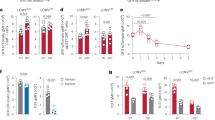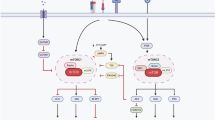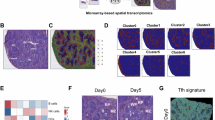Abstract
An essential event in the development of memory CD8+ T lymphocytes is the escape of progenitors from programmed cell death, but how this is mediated is unclear. Here we report that the gene encoding serine protease inhibitor 2A (Spi2A), an inhibitor of lysosomal executioner proteases dependent on transcription factor NF-κB, is upregulated in memory cell precursors. Spi2A upregulation protected lymphocytic choriomeningitis virus–specific memory progenitors from programmed cell death. Thus, Spi2A promotes the survival of cytotoxic T lymphocytes, allowing them to differentiate into memory CD8 T cells. These findings suggest a model in which commitment to the memory lineage is facilitated by the upregulation of protective genes.
This is a preview of subscription content, access via your institution
Access options
Subscribe to this journal
Receive 12 print issues and online access
$259.00 per year
only $21.58 per issue
Buy this article
- Purchase on SpringerLink
- Instant access to full article PDF
Prices may be subject to local taxes which are calculated during checkout





Similar content being viewed by others
References
Zinkernagel, R.M. & Doherty, P.C. Restriction of in vitro T cell mediated cytotoxicity in lymphocytic choriomeningitis within a syngeneic or semi-allogeneic system. Nature 248, 701–702 (1974).
Huesel, J.W., Wesselschmidt, S., Shresta, S., Russell, J.H. & Ley, T.J. Cytotoxic lymphocytes require granzyme B for the rapid induction of DNA fragmentation and apoptosis in allogeneic target cells. Cell 76, 977–987 (1994).
Kagi, D. et al. Cytotoxicity mediated by T cells and natural killer cells is greatly impaired in perforin-deficient mice. Nature 369, 31–37 (1994).
Kagi, D. et al. Fas and perforin pathways as major mechanisms of T cell-mediated cytotoxicity. Science 265, 528–530 (1994).
Ahmed, R. & Gray, D. Immunological memory and protective Immunity: understanding their relationship. Science 272, 54–60 (1996).
Murali-Krishna, K. et al. Counting antigen-specific CD8 T cells: a reevaluation of bystander activation during viral infection. Immunity 8, 177–187 (1998).
Berard, M. & Tough, D.F. Qualitative differences between naive and memory T cells. Immunology 106, 127–138 (2002).
Hu, H. et al. CD4+ T cell effectors can become memory cells with high efficiency and without further cell division. Nat. Immunol. 2, 705–710 (2001).
Jacob, J. & Baltimore, D. Modelling T-cell memory by genetic marking of memory T cells in vivo. Nature 399, 593–597 (1999).
Kaech, S.M., Hemby, S., Kersh, E. & Ahmed, R. Molecular and functional profiling of memory CD8 T cell differentiation. Cell 111, 837–851 (2002).
Opferman, J.T., Ober, B.T. & Ashton-Rickardt, P.G. Linear differentiation of cytotoxic effectors into memory T lymphocytes. Science 283, 1745–1748 (1999).
Kisielow, P., Bluthmann, H., Staerz, U.D., Steinmetz, M. & von Boehmer, H. Tolerance in T-cell-receptor transgenic mice involves deletion of nonmature CD4+8+ thymocytes. Nature 333, 742–746 (1988).
Liu, N. et al. NF-κB protects from the lysosomal pathway of cell death. EMBO J. 22, 5313–5322 (2003).
Medhurst, A.D. et al. The use of TaqMan RT-PCR assays for semiquantitative analysis of gene expression in CNS tissues and disease models. J. Neurosci. Meth. 98, 9–20 (2000).
Kaech, S.M. et al. Selective expression of the interferon 7 receptor identifies effector CD8 T cells that give rise to long-lived memory cells. Nat. Immunol. 4, 1191–1198 (2004).
Madakamutil, L.T. et al. CD8αα-mediated survival and differentiation of CD8 memory T cell precursors. Science 304, 590–593 (2004).
Zang, X. & Ren, R. Bcr-Abl efficiently induces a myeloproliferative disease and production of excess interleukin-3 and granulocyte-macrophage colony-stimulating factor in mice: a novel model of chronic myelogenous leukemia. Blood 92, 3829–3840 (1998).
Fueng-Leung, W.P. et al. CD8 is needed for development of cytotoxic cells but not helper cells. Cell 65, 443–449 (1991).
Sun, J. et al. A new family of 10 murine ovalbumin serpins includes two homologs of proteinase inhibitor 8 and two homologs of the granzyme B inhibitor (proteinase inhibitor 9). J. Biol. Chem. 272, 15434–15441 (1997).
Inglis, J.D., Lee, M., Davidson, D.R. & Hill, R.E. Isolation of two cDNAs encoding novel α1-antichymotrypsin-like proteins in a murine chondrocytic cell line. Gene 106, 213–220 (1991).
Suzuki, Y., Yamamoto, K. & Sinohara, H. Molecular cloning and sequence analysis of full-length cDNA coding for mouse contrapsin. J. Biochem 108, 344–346 (1990).
Liu, N., Wang, Y. & Ashton-Rickardt, P.G. Serine protease inhibitor 2A (Spi2A) inhibits caspase-independent programmed cell death. FEBS Lett. 569, 49–53 (2004).
Michallet, M.C., Saltel, F., Flacher, M., Revillard, J.P. & Genestier, L. Cathepsin-dependent apoptosis triggered by supraoptimal activation of T lymphocytes: a possible mechanism of high dose tolerance. J. Immunol. 172, 5405–5414 (2004).
Foghsgaard, L. et al. Cathepsin B acts as a dominant execution protease in tumor cell apoptosis induced by tumor necrosis factor. J. Cell. Biol. 153, 999–1009 (2001).
Guicciardi, M.E. et al. Cathepsin B contributes to TNF-α-mediated hepatocyte apoptosis by promoting mitochondrial release of cytochrome c. J. Clin. Invest. 106, 1127–1137 (2000).
Idziorek, T., Estaquier, J., DeBels, F. & Ameisen, J.-C. YOPRO-1 permits cytofluorometric analysis of programmed cell death (apoptosis) without interfering with cell viability. J. Immunol. Methods 185, 249–258 (1995).
Hou, S., Hyland, L., Ryan, K.W., Portner, A. & Doherty, P.C. Virus-specific CD8+ T-cell memory determined by clonal burst size. Nature 369, 652–654 (1994).
Suresh, M. et al. Role of CD28-B7 interactions in generation and maintenance of CD8 T cell memory. J. Immunol. 167, 5565–5573 (2001).
Grayson, J.M., Murali-Krishna, K., Altman, J.D. & Ahmed, R. Gene expression in antigen-specific CD8+ T cells during viral infection. J. Immunol. 166, 795–799 (2001).
Grayson, J.M., Zajac, A.J., Altman, J.D. & Ahmed, R. Cutting edge: increased expression of Bcl-2 in antigen-specific memory CD8+ T cells. J. Immunol. 164, 3950–3954 (2000).
Razvi, E.S., Jiang, Z., Woda, B.A. & Welsh, R.M. Lymphocyte apoptosis during the silencing of the immune response to acute viral infections in normal, lpr, and Bcl-2-transgenic mice. Am. J. Path. 147, 79–91 (1995).
Petschner, F. et al. Constitutive expression of Bcl-xL or Bcl-2 prevents peptide antigen-induced T cell deletion but does not influence T cell homeostasis after viral infection. Eur. J. Immunol. 28, 560–569 (1998).
Ferri, K.F. & Kroemer, G. Organelle-specific initiation of cell death pathways. Nat. Cell Biol. 3, E255–E263 (2001).
Badovanic, V.P., Tvinnereim, A.R. & Harty, J.T. Regulation of antigen-specific T cell homeostasis by perforin and interferon-γ. Science 290, 1354–1357 (2000).
Hettmann, T., Opferman, J.T., Leiden, J.M. & Ashton-Rickardt, P.G. A critical role for NF-κB transcription factors in the development CD8+ memory-phenotype T cells. Immunol. Lett. 85, 297–300 (2003).
Mora, A.L. et al. Antiapoptotic function of NF-κB in T lymphocytes is influenced by their differentiation status: roles of Fas, and Bcl-XL . Cell Death Differ. 10, 1032–1044 (2003).
Badovinac, V.P., Porter, B.B. & Harty, J.T. CD8+ T cell contraction is controlled by early inflammation. Nat. Immunol. 5, 809–817 (2004).
Hamerman, J.A. et al. Serpin 2a is induced in activated macrophages and conjugates to a ubiquitin homolog. J. Immunol. 168, 2415–2423 (2002).
Balaji, K.N., Schaschke, N., Machleidt, W., Catlfamo, M. & Henkart, P.A. Surface cathepsin B protects cytotoxic lymphocytes from self-destruction after degranulation. J. Exp. Med. 196, 493–503 (2002).
Chen, L., Woo, M., Hakem, R. & Miller, J.D. Perforin-dependent activation-induced cell death acts through caspase 3 but not through caspases 8 or 9. Eur. J. Immunol. 33, 769–778 (2003).
Mombaerts, P. et al. RAG-1-deficient mice have no mature B and T lymphocytes. Cell 68, 869–877 (1992).
Markiewicz, M.A. et al. Long-term T cell memory requires the surface expression of self-peptide/major histocompatibility complex molecules. Proc. Natl. Acad. Sci. USA 95, 3065–3070 (1998).
Lin, M.Y. & Welsh, R.M. Stability and diversity of T cell receptor repertoire usage during lymphocytic virus infection of mice. J. Exp. Med. 188, 1993–2001 (1998).
Ober, B.T. et al. Affinity of thymic self-peptides for the TCR determines the selection of CD8+ T lymphocytes in the thymus. Int. Immunol. 12, 1353–1363 (2000).
Coligan, J.E., Kruisbeek, A.M., Margulis, D.H., Shevach, E.M. & Strober, W. Current Protocols in Immunology (John Wiley and Sons, New York, 1995).
Wognum, A.W., Visser, T.P., Peters, K., Bierhuizen, M.F.A. & Wagemaker, G. Stimulation of mouse bone marrow cells with Kit ligand, FLT3 ligand and thrombopoietin leads to efficient retroviral-mediated gene transfer to stem cells, whereas interleukin 3 and interleukin 11 reduces transduction of short- and long-term repopulating cells. Hum. Gene Ther. 11, 2129–2141 (2000).
Acknowledgements
We thank R. Welsh for high-titer stocks of LCMV Armstrong; J. Marvin and R. Duggan for help with flow cytometry; and G. Franzoso and S. Byrne for comments. Supported by Medical Scientist Training Program (GM07281 to T.P.) and National Institutes of Health (AI45108 to P.G.A-R.)
Author information
Authors and Affiliations
Corresponding author
Ethics declarations
Competing interests
The authors declare no competing financial interests.
Supplementary information
Supplementary Fig. 1
Expression of epitope-tagged Spi2A in BM chimeras. (PDF 98 kb)
Supplementary Fig. 2
Effect of Spi2A expression on the level of IL-7Rhi anti-LCMV CD8 T cells. (PDF 86 kb)
Supplementary Fig. 3
Effect of Spi2A on the level of IL-7R expression in anti-LCMV CD8 T cells. (PDF 66 kb)
Supplementary Fig. 4
Induction of Spi2A mRNA in CD8 T cells by IL-7 in vitro. (PDF 63 kb)
Supplementary Fig. 5
Inhibition of cathepsin B reduces PCD of anti-LCMV CD8 T cells in vitro. (PDF 78 kb)
Supplementary Fig. 6
Effect of CA-074 Me and Spi2A on cytoplasmic cathepsin B activity. (PDF 72 kb)
Supplementary Table 1
DNA 11kA array analysis of gene expression in B6.2.16 CD8 cells. (PDF 132 kb)
Supplementary Table 2
DNA 11kB array analysis of gene expression in B6.2.16 CD8 cells. (PDF 100 kb)
Supplementary Table 3
Relative Expression of Candidate genes in Memory compared to Naïve CD8 cells. (PDF 42 kb)
Supplementary Table 4
Generation of bone marrow chimeras transduced with retrovirus. (PDF 30 kb)
Supplementary Table 5
Levels of thymocytes in bone marrow chimeras transduced with retrovirus. (PDF 31 kb)
Supplementary Table 6
Levels of mature T cells in peripheral lymphoid organs of chimeras transduced with retrovirus. (PDF 33 kb)
Rights and permissions
About this article
Cite this article
Liu, N., Phillips, T., Zhang, M. et al. Serine protease inhibitor 2A is a protective factor for memory T cell development. Nat Immunol 5, 919–926 (2004). https://doi.org/10.1038/ni1107
Received:
Accepted:
Published:
Issue date:
DOI: https://doi.org/10.1038/ni1107
This article is cited by
-
N6-methyladenosine of Spi2a attenuates inflammation and sepsis-associated myocardial dysfunction in mice
Nature Communications (2023)
-
Transcriptome profiling of CTLs regulated by rapamycin using RNA-Seq
Immunogenetics (2014)
-
Genome-Wide Profiling of In Vivo LPS-Responsive Genes in Splenic Myeloid Cells
Molecules and Cells (2013)
-
Killing a cancer: what are the alternatives?
Nature Reviews Cancer (2012)
-
Stat3 controls lysosomal-mediated cell death in vivo
Nature Cell Biology (2011)



